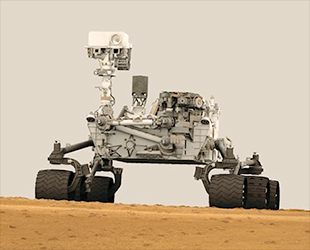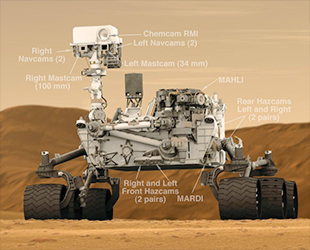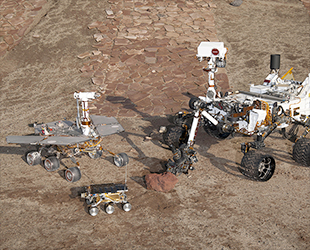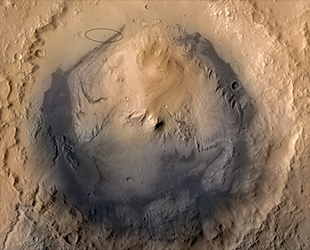August 6, 2012 — NASA has a new six-wheeled science lab on Mars.
The car-size Curiosity rover touched down safely on the Red Planet at 1:17:57 a.m. EDT (0517 GMT) on Monday (Aug. 6), after eight months cruising from Earth to Mars. Leading up to the landing was a 7-minute automated entry and descent through the planet's atmosphere that relied on thrusters, a supersonic parachute, eight retrorockets and a "sky crane" to deposit the nearly one-ton, nuclear-powered rover at Gale Crater.
Confirmation of the landing came as signals from Curiosity — being relayed by NASA's Odyssey spacecraft in Mars' orbit — reached the Earth. The distance between the two planets translated to a 14 minute delay between the actual touchdown and when the team at NASA's Jet Propulsion Laboratory (JPL) in Pasadena, Calif., could declare that the rover was safe on the surface.
"Touchdown confirmed. We are safe on Mars!" exclaimed Allen Chen, NASA's Mars Science Laboratory (MSL) lead for entry, descent, and landing operations.
A televised view inside the control room showed the team members cheering, applauding and hugging each other as they celebrated their success.

Artist rendition of NASA's Curiosity rover on Mars. (NASA/JPL) |
"Tonight on the planet Mars, the United States of America made history," President Obama said in a statement that was released shortly after the landing. "I congratulate and thank all the men and women of NASA who made this remarkable accomplishment a reality – and I eagerly await what Curiosity has yet to discover."
Outfitted with a robotic arm, a drill, sample scoop, cutting edge instruments and a number of cameras — including a laser-equipped, spectrum-reading camera for detecting the chemical make-up of target rocks, Curiosity is the most advanced robotic probe ever sent to the surface of another planet. The rover will use these tools to study whether the Gale crater area — including a 3-mile high (5.6 kilometers) mound — has evidence of past and present environments habitable to supporting life.
"We're going to have the opportunity for untold discovery," Doug McCuistion, NASA's director for its Mars Exploration Program, told reporters Sunday (Aug. 5). "This location at Gale Crater is absolutely amazing, a place we could have never thought of getting to just a few years ago."
"It's a 2-year mission, not a 90-day mission, so be patient. We're going to be doing this sequentially, intelligently [and] smartly. It is a complex system," McCuistion added.
First photos
Curiosity won't begin roving around Gale Crater until early September, but it almost immediately began sharing with Earth its surroundings using its cameras.

This thumbnail image shows one of the first views from NASA's Curiosity rover, taken through the fisheye wide-angle lens on one of the rover's hazard-avoidance cameras (Hazcams). (NASA) |
Curiosity's first images arrived within just a few minutes of it touching down. The snapshots were taken with the left and right hazard detection cameras (Hazcams) mounted at the back and front of the rover. The images were small thumbnail copies, just 64 by 64 and 256 by 256 pixels in size.
The Hazcams are equipped with very wide-angle, fisheye lenses, initially capped with clear dust covers. The covers are designed to protect the cameras from dust that may be kicked up during landing; they're clear just in case they don't pop off as expected.
These thumbnail views gave the mission team a first look at what surrounds Curiosity, as well as an early indication as to the rover's location and tilt.

Graphic showing the locations of the numerous engineering and science cameras mounted on NASA's Curiosity rover. (NASA) |
Color pictures from the rover's Mars Descent Imager, or MARDI, taken as the rover descended to Gale Crater, will help pinpoint the rover's location. The initial images from MARDI are expected to be received later on Monday (Aug. 6). They too will be thumbnail size, although a single, full resolution image is possible as well.
Additional color views of the planet's surface are expected the next day from the Mars Hand Lens Imager, or MAHLI, one of five devices on the rover's "Inspector Gadget"-like arm. The camera is designed to take close-up pictures of rocks and soil, but can also be used to take photos out to the horizon. With Curiosity's robot arm still in the stowed position, the camera will be pointed to the side, allowing it to take an initial color view of the Gale Crater area.
Once Curiosity's mast is erected, the navigation cameras (Navcams) will begin taking stereo panoramas around the area as well as photographs of the rover's deck. Navcam photos are expected to begin arriving on Earth about three days after landing, if the mast is deployed on schedule.
Also about three days after landing, the narrower field of view Mast Cameras, or Mastcams, are expected to start snapping their first shots. These color cameras will reveal the rover's new home in exquisite detail. Small thumbnails will be sent first, before a high-resolution panorama follows more than a week later.
Life on Mars
Curiosity's planned operational life is one Martian year, or 687 Earth days.
The rover's main assignment is to investigate whether its Gale Crater landing area has ever offered environmental conditions that are favorable for microbial life. To do that, it packs a science payload weighing 15 times as much as the science instruments on previous Mars rovers.

This grouping of two test rovers and a flight spare provides a graphic comparison of three generations of rovers developed at NASA's Jet Propulsion Laboratory, Pasadena, Calif. (NASA/JPL) |
A suite of instruments named "Sample Analysis at Mars" will analyze samples collected and delivered by the rover's arm. It includes three science instruments with combined capabilities to identify a wide range of organic compounds and determine the ratios of isotopes of key elements that can serve as clues to understanding the history of Mars' atmosphere and water.
An X-ray diffraction and fluorescence instrument called CheMin will also examine samples gathered by the robotic arm. It is designed to identify and quantify the minerals in rocks and soils, and to measure bulk composition.
Mounted on the arm, the Mars Hand Lens Imager will take extreme close-up pictures of rocks, soil and, if present, ice, revealing details smaller than the width of a human hair. It will also be able to focus on hard-to-reach objects more than an arm's length away.
Also supported by the arm, the Canadian Space Agency's Alpha Particle X-ray Spectrometer for MSL will determine the relative abundances of different elements in rocks and soils.
An instrument named ChemCam will use laser pulses to vaporize thin layers of material from Martian rocks or soil targets up to 9 meters (30 feet) away. It includes both a spectrometer to identify the types of atoms excited by the beam, and a telescope to capture detailed images of the area illuminated by the beam.
The laser and telescope sit on the rover's mast and share with the Mast Camera the role of informing researchers' choices about which objects in the area make for the best targets for approaching to examine with other instruments.
Finally, the rover's Radiation Assessment Detector (RAD) will characterize the radiation environment at the surface of Mars. This information is necessary for planning human exploration missions of Mars and is relevant to assessing the planet's ability to harbor life.

Composite photo of Gale Crater on Mars. The elipse in the upper left represents Curiosity's targeted landing area. (NASA/JPL) |
The rover's landing area sits in a safely flat area between the less-safe slopes of the rim of 96-mile (154 kilometers) wide Gale Crater and its central peak, informally known as "Mount Sharp." Curiosity's touchdown point was plotted to be within driving distance of layers on Mount Sharp, where minerals that formed in water have been seen from orbit.
collectSPACE will be providing continuing coverage of the Curiosity rover mission, live from NASA's Jet Propulsion Laboratory (JPL) in Pasadena, Calif.
